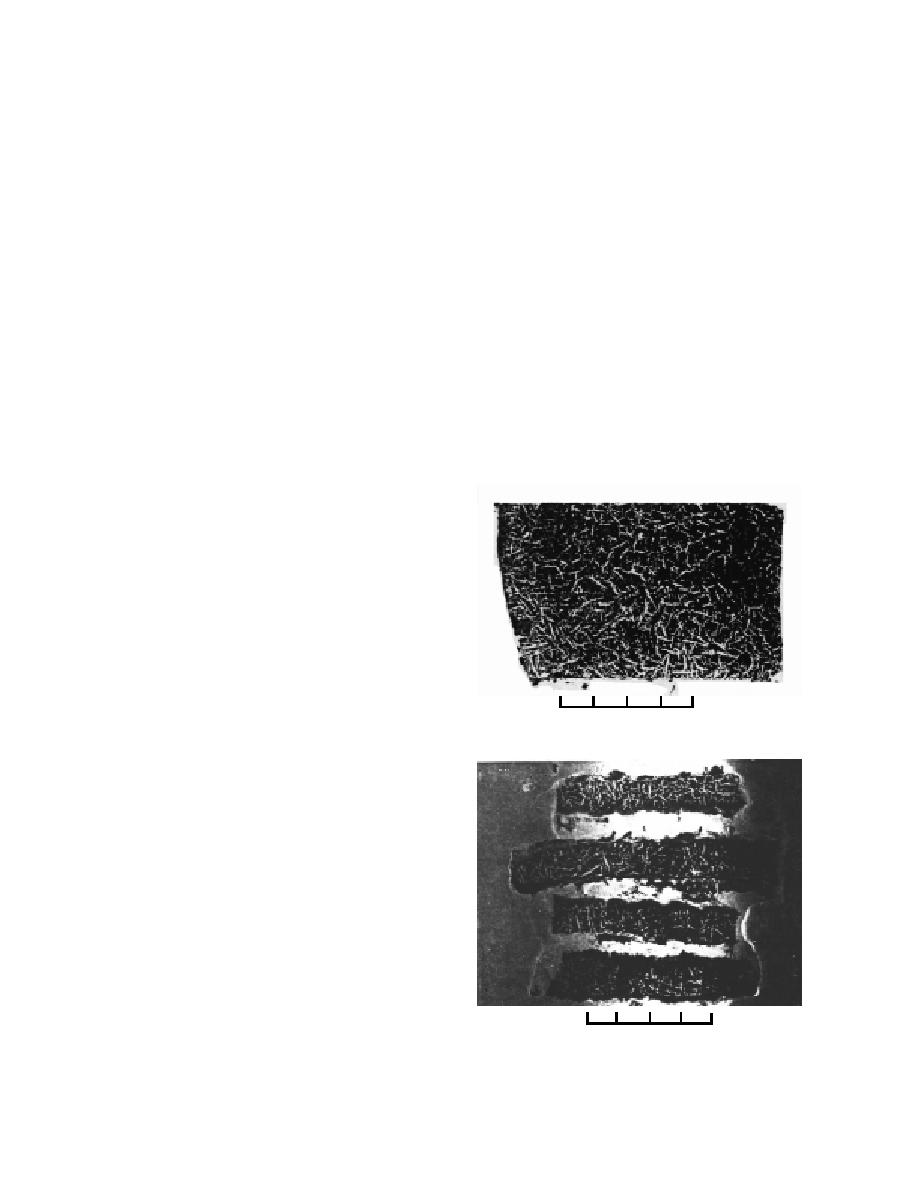
interesting result, as the thin sections (examples
the natural clay test pads. Ice lenses and shrinkage
cracks were not as prevalent as they were in cores
in Fig. 14) showed many randomly oriented ice
from the natural clay test pads. The ice appeared
lenses surrounding aggregates of bentonite. In
just as crystals in the sandbentonite matrix. Fur-
contrast to the low swelling characteristics of the
thermore, excavations into the sandbentonite test
Parkview and Valley Trail clays, the bentonite has
pad after thawing in both years revealed no blocky
a great affinity for water, even after freezing and
structure caused by ice lenses and shrinkage
thawing. The difference is attributable to the
cracks, as was observed for the clay test sections.
highly swelling nature of the "smechtite" clay
Uniformity of the percentage of bentonite
mineral in bentonite and the relatively low swell-
appeared to have a greater effect on hydraulic con-
ing characteristics of the clay minerals in the com-
ductivity of the sandbentonite than did freeze
pacted clay soils. This caused a reversal of the
thaw. Laboratory tests done at UW-Madison indi-
segregated structure formed during freezing of
cated that higher hydraulic conductivity in the
the GCLs and complete recovery of the hydrated
large-diameter sandbentonite specimens was
structure that restricts the flow of water through
caused by preferential flow through paths contain-
the GCL systems.
ing less bentonite. Piping (formation of channels)
The bentonite continued to hydrate under the
low surcharge stress (1 lb/in.2 [6.9 kPa]) during
appeared in each of the UW-Madison tests and in
some of the tests done in the CRREL laboratory.
the hydraulic conductivity tests, both before and
Additional observations of the sandbentonite,
after freezing and thawing. The swelling made
after the field permeameter was disassembled,
the hydraulic conductivity determinations diffi-
showed that the bentonite in the near-surface
material had become soft and was wetter than that
deeper in the section. Specimens removed from
depths of 3, 5.5, and 8 in. (8, 14, and 20 cm) showed
water contents of 42.1, 20.4, and 18.2%. The high
water content at the surface is attributed to hydra-
tion of bentonite and swelling because of low con-
fining pressure. This swelling also caused prob-
lems in doing the laboratory hydraulic conductiv-
ity tests. There was little or no flow of water
through the test specimens because of the low
effective stresses used and the continuous swell-
ing of the sandbentonite mixture. Since the deter-
mination of the hydraulic conductivity required
0
1
2
3 4 cm
the measurement of the flow of water both into
a. Horizontal.
and out of the test specimens, and since the flow
rate of water was very slow for the low hydraulic
conductivities measured, the swelling would
mask the outflow and result in artificially high
inflow rates. Thus, a considerable amount of time
was required for the swelling to diminish and the
inflow and outflow volumes to balance. Higher
confining pressures than typically used (about 1
lb/in.2 [6.9 kPa]) in laboratory hydraulic conduc-
tivity tests would have reduce the swelling prob-
lem. However, the laboratory tests reported here
intentionally used low confining pressures com-
mensurate with those in the field tests.
Hydraulic conductivity of GCLs
Laboratory test results
0
1
2
3
4 cm
The laboratory test results on the GCL materials
b. Vertical.
showed almost no change in the hydraulic con-
ductivity from freezing and thawing. This was an
Figure 14. Thin sections of a frozen Bentomat GCL.
13



 Previous Page
Previous Page
